Corrosion Resistance of Nickel/Chromium Graphene Oxide Coatings on Copper Substrate Surface and the Corrosion Resistance Mechanism of Graphene Oxide
Abstract
1. Introduction
2. Experiment
2.1. Electrodeposition
2.2. Characterization
3. Results and Discussion
3.1. The Infrared Spectra of NiCr-GO Coating
3.2. Coating Microstructure (SEM) and Porosity
3.2.1. Coating Microstructure (SEM)
3.2.2. Coating Porosity
3.3. Coating Structure and Phase Composition (XRD)
3.4. Electrochemical Analysis
3.4.1. Tafel Polarization Curve
3.4.2. Electrochemical Impedance Spectroscopy (EIS)
3.4.3. Static Immersion Corrosion Test
3.5. The Double Coupling Mechanism of GO Corrosion Resistance
3.5.1. The Barrier Corrosion Resistance Mechanism of GO
3.5.2. Corrosion Resistance Mechanism of Passivation Film
4. Conclusions
- (1)
- NiCr coating and NiCr-GO composite coating with different amounts of GO were successfully prepared on copper substrate by direct current electroplating method.
- (2)
- NiCr-GO coatings consisted of Ni phase, Cr phase, and Cr2Ni3 intermetallic compound. The addition of GO did not change the phase texture of the NiCr alloy coating, and had no obvious impacts on the crystallite size of Ni and Cr2Ni3. There was not much difference in the NiCr and NiCr-GO coatings thickness.
- (3)
- The corrosion resistance of NiCr-GO coating was better than that of NiCr. When the addition amount of GO was 0.750 g/L, NiCr-GO coating showed the best corrosion resistance.
- (4)
- GO achieved improvement of corrosion resistance through “dual coupling” mechanism. Firstly, as a “physical barrier”, GO sheets constructed multi-level detour penetration paths in crack/porosity and superimpose a surface shielding layer, significantly delaying the intrusion of Cl−. Secondly, owning to rich oxygen-containing functional groups in GO, oxide corrosion products were easier to form, which could act as a surface passivation film to prevent the penetration of corrosive media.
Author Contributions
Funding
Institutional Review Board Statement
Informed Consent Statement
Data Availability Statement
Conflicts of Interest
References
- Ding, C.; Tai, Y.; Wang, D.; Tan, L.; Fu, J. Superhydrophobic composite coating with active corrosion resistance for AZ31B magnesium alloy protection. Chem. Eng. J. 2019, 357, 518–532. [Google Scholar] [CrossRef]
- Qian, H.; Xu, D.; Du, C.; Zhang, D.; Li, X.; Huang, L.; Deng, L.; Tu, Y.; Mol, J.M.C.; Terryn, H.A. Dual-action smart coatings with a self-healing superhydrophobic surface and anti-corrosion properties. J. Mater. Chem. A 2017, 5, 2355–2364. [Google Scholar] [CrossRef]
- Oduoza, C.F.; Hingley, S. Electrochemical evaluation of corrosion resistance of chromium plated nickel and copper tin alloys. A comparative study. J. Electrochem. Sci. Eng. 2018, 8, 227–239. [Google Scholar] [CrossRef]
- He, X.; Hou, B.; Cai, Y.; Li, C.; Jiang, Y.; Wu, L. Electrodepositing behaviors and properties of nano Fe-Ni-Cr/SiC composite coatings from trivalent chromium baths containing compound carboxylate-urea system. J. Nanosci. Nanotechnol. 2013, 13, 4031–4039. [Google Scholar] [CrossRef]
- Tulio, P.C.; Carlos, I.A. Effect of SiC and Al2O3 particles on the electrodeposition of Zn, Co and ZnCo: II. Electrodeposition in the presence of SiC and Al2O3 and production of ZnCo–SiC and ZnCo–Al2O3 coatings. J. Appl. Electrochem. 2009, 39, 1305–1311. [Google Scholar] [CrossRef]
- He, X.Z.; Zhou, X.L.; Zhang, X.W.; Sun, X. Characterization of Cr-Ni-ZrO2 composite coatings electrodeposited from Cr(III) plating bath. Adv. Mater. Res. 2011, 239–242, 2733–2737. [Google Scholar] [CrossRef]
- Dimiev, A.M.; Ceriotti, G.; Metzger, A.; Kim, N.D.; Tour, J.M. Chemical mass production of graphene nanoplatelets in ~100% yield. ACS Nano 2016, 10, 274–279. [Google Scholar] [CrossRef] [PubMed]
- Nasrollahzadeh, M.; Babaei, F.; Fakhri, P.; Jaleh, B. Synthesis, characterization, structural, optical properties and catalytic activity of reduced graphene oxide/copper nanocomposites. RSC Adv. 2015, 5, 10782–10789. [Google Scholar] [CrossRef]
- Wang, Y.; Li, S.; Yang, H.; Luo, J. Progress in the functional modification of graphene/graphene oxide: A review. RSC Adv. 2020, 10, 15328–15345. [Google Scholar] [CrossRef]
- Liu, C.; Wei, D.; Huang, X.; Mai, Y.; Zhang, L.; Jie, X. Electrodeposition of Co–Ni–P/graphene oxide composite coating with enhanced wear and corrosion resistance. J. Mater. Res. 2019, 34, 1726–1733. [Google Scholar] [CrossRef]
- Sharma, N.; Yadav, D.; Hassan, M.I.; Srivastava, C.M.; Majumder, S. A review on exploring the impact of graphene oxide-based nanomaterials on structures and bioactivity of proteins. J. Mol. Liq. 2024, 404, 124980. [Google Scholar] [CrossRef]
- Tseluikin, V.; Dzhumieva, A.; Yakovlev, A.; Tikhonov, D.; Tribis, A.; Strilets, A.; Lopukhova, M. Electrodeposition and properties of composite Ni coatings modified with multilayer graphene oxide. Micromachines 2023, 14, 1747. [Google Scholar] [CrossRef]
- Ozkan, D.; Erarslan, Y.; Kincal, C.; Gurlu, O.; Yagci, M.B. Wear and corrosion resistance enhancement of chromium surfaces through graphene oxide coating. Surf. Coat. Technol. 2020, 391, 125595. [Google Scholar] [CrossRef]
- Arora, S.; Srivastava, C. Microstructure and corrosion properties of NiCo–graphene oxide composite coatings. Thin Solid Films 2019, 677, 45–54. [Google Scholar] [CrossRef]
- Tseluikin, V.; Dzhumieva, A.; Yakovlev, A.; Mostovoy, A.; Lopukhova, M. Electrodeposition of graphene oxide modified composite coatings based on nickel–chromium alloy. Crystals 2021, 11, 415. [Google Scholar] [CrossRef]
- Duru, E.; Akyuz, M.; Gultekin, D.; Algul, H.; Akbulut, H.; Uysal, M. Reciprocating dry sliding friction and wear behavior of graphene oxide-reinforced Ni–Co composite coatings. Diam. Relat. Mater. 2025, 154, 112210. [Google Scholar] [CrossRef]
- Li, B.; Chen, S.; Xiao, M.; Tu, Q.; Xu, Z.; Feng, T.; Zhang, Z.; Yuan, Z.; Xu, C.; Gong, L.; et al. Preparation of Ni–Mo/GO composite coatings with strengthened mechanical properties and enhanced corrosion resistance. Surf. Coat. Technol. 2024, 477, 130404. [Google Scholar] [CrossRef]
- Sassi, W.; Zrelli, R.; Hihn, J.-Y.; Berçot, P.; Rezrazi, M.; Ammar, S. Silicate dip-coat mechanism as an inhibitor against copper dissolution into alkaline chloride media. J. Bio-Tribo-Corros. 2020, 6, 50. [Google Scholar] [CrossRef]
- JB/T 7901-1999; Metallic Materials—Laboratory Uniform Corrosion Test—Full Immersion Method. China Machinery Industry Press: Beijing, China, 1999.
- Brusko, V.; Khannanov, A.; Rakhmatullin, A.; Dimiev, A.M. Unraveling the infrared spectrum of graphene oxide. Carbon 2024, 229, 119507. [Google Scholar] [CrossRef]
- Li, S.; Song, G.; Zhang, Y.; Fu, Q.; Pan, C. Graphene-reinforced Zn–Ni alloy composite coating on iron substrates by pulsed reverse electrodeposition and its high corrosion resistance. ACS Omega 2021, 6, 13728–13741. [Google Scholar] [CrossRef] [PubMed]
- Mohamed, M.E.; Mekhaiel, P.S.; Mahgoub, F.M. Construction of superhydrophobic graphene-based coating on steel substrate and its ultraviolet durability and corrosion resistance properties. Sci. Rep. 2023, 13, 590. [Google Scholar] [CrossRef]
- Yang, B.; Zhang, P.; Wang, G.; Wang, A.; Chen, X.; Wei, S.; Xie, J. Effect of graphene oxide concentration in electrolyte on corrosion behavior of electrodeposited Zn–electrochemical reduction graphene composite coatings. Coatings 2019, 9, 758. [Google Scholar] [CrossRef]
- Walsh, F.C.; Ponce de Leon, C.; Kerr, C.; Court, S.; Barker, B.D. Electrochemical characterisation of the porosity and corrosion resistance of electrochemically deposited metal coatings. Surf. Coat. Technol. 2008, 202, 5092–5102. [Google Scholar] [CrossRef]
- GB/T 17721-1999; Test for Porosity of Metallic Coatings: Ferric Reagent Test [S]. Standards Press of China: Beijing, China, 1999.
- Sun, C.; Hu, G.; Cao, L.; Pan, T.; Guo, C.; Xia, Y. Ni/graphene coating for enhanced corrosion resistance of metal foam flow field in simulated PEMFC cathode environment. ACS Omega 2024, 9, 29797–29804. [Google Scholar] [CrossRef] [PubMed]
- Leenaers, A.J.G.; Vrakking, J.J.A.M.; de Boer, D.K.G. Glancing incidence X-ray analysis: More than just reflectivity. Spectrochim. Acta Part B 1997, 52, 805–812. [Google Scholar] [CrossRef]
- Zhang, Y.; Zhou, W.; Yu, H.; Feng, T.; Pu, Y.; Liu, H.; Xiao, W.; Tian, L. Self-templated synthesis of nickel silicate hydroxide/reduced graphene oxide composite hollow microspheres as highly stable supercapacitor electrode material. Nanoscale Res. Lett. 2017, 12, 325. [Google Scholar] [CrossRef] [PubMed]
- Klug, H.P.; Alexander, L.E. X-Ray Diffraction Procedures: For Polycrystalline and Amorphous Materials, 2nd ed.; Wiley: Hoboken, NJ, USA, 1974. [Google Scholar]
- Sherwin, C.; Raju, K.; Meena, P.L.; Tyagi, R.; Mohan, C. Optimization of current density for nickel–chromium (Ni–Cr) alloy coating on copper: An experimental approach. Discov. Appl. Sci. 2025, 7, 324. [Google Scholar] [CrossRef]
- Wang, S.; Zhang, J.; Gharbi, O.; Vivier, V.; Gao, M.; Orazem, M.E. Electrochemical impedance spectroscopy. Nat. Rev. Methods Primers 2021, 1, 41. [Google Scholar] [CrossRef]
- Zhang, Q.; Liu, X.; Jiang, Y.; Xiao, F.; Wang, W.; Duan, J. Graphene research progress in the application of anticorrosion and antifouling coatings. Crystals 2025, 15, 541. [Google Scholar] [CrossRef]
- Wang, N.; Gao, H.; Zhang, J.; Kang, P. Effect of graphene oxide/ZSM-5 hybrid on corrosion resistance of waterborne epoxy coating. Coatings 2018, 8, 179. [Google Scholar] [CrossRef]
- Mansfeld, F. Area relationships in galvanic corrosion. Corrosion 1971, 27, 436–442. [Google Scholar] [CrossRef]

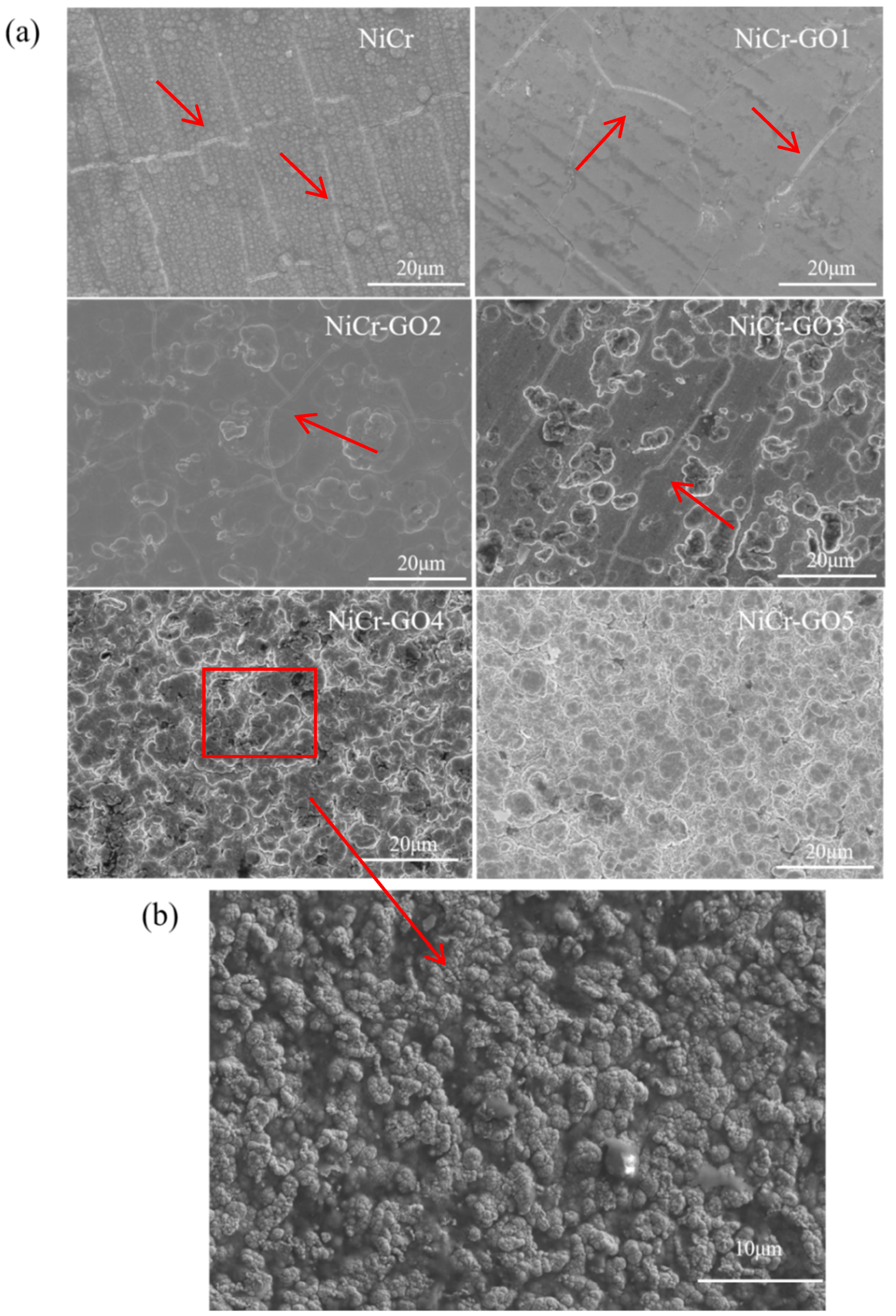
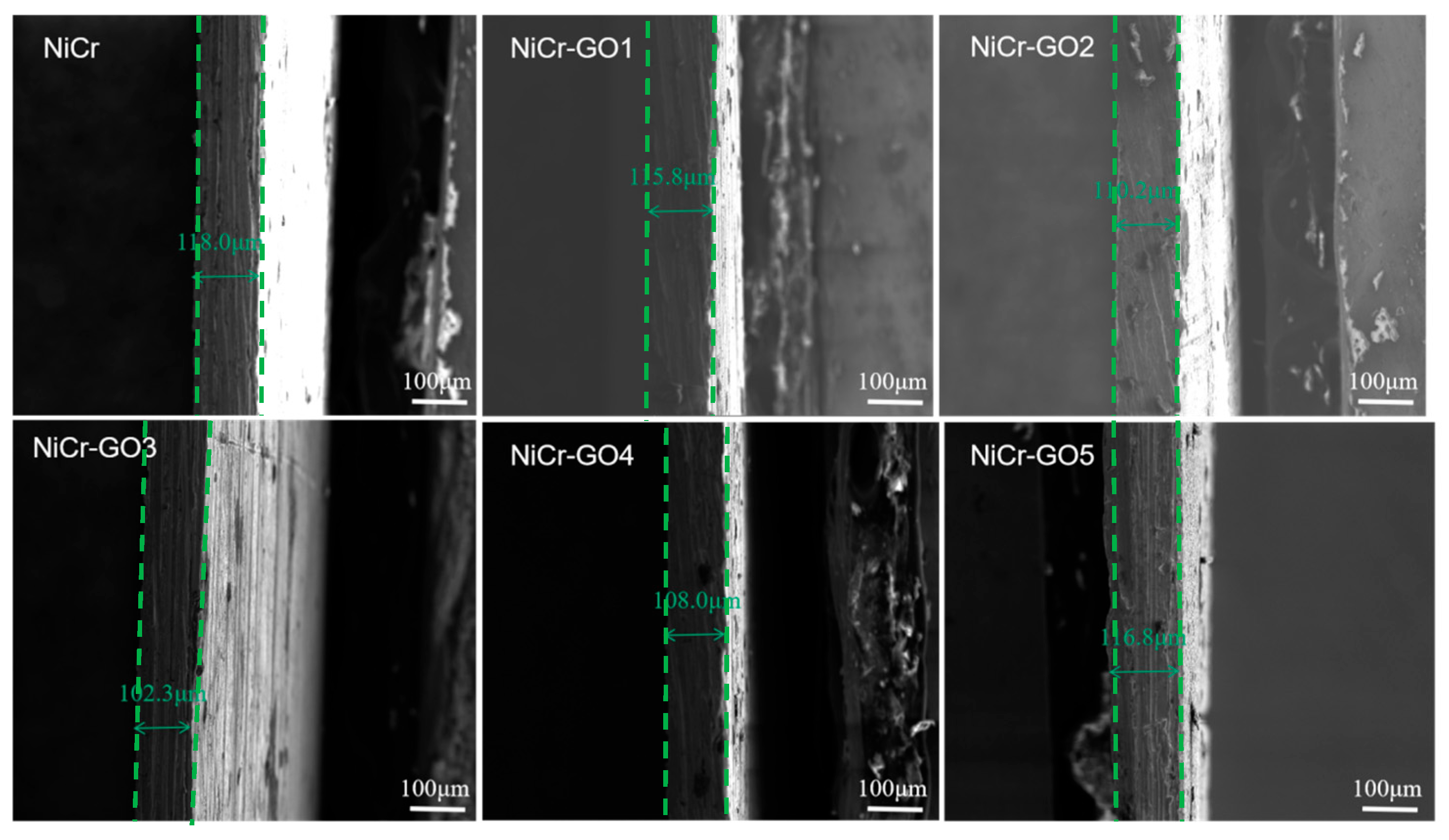
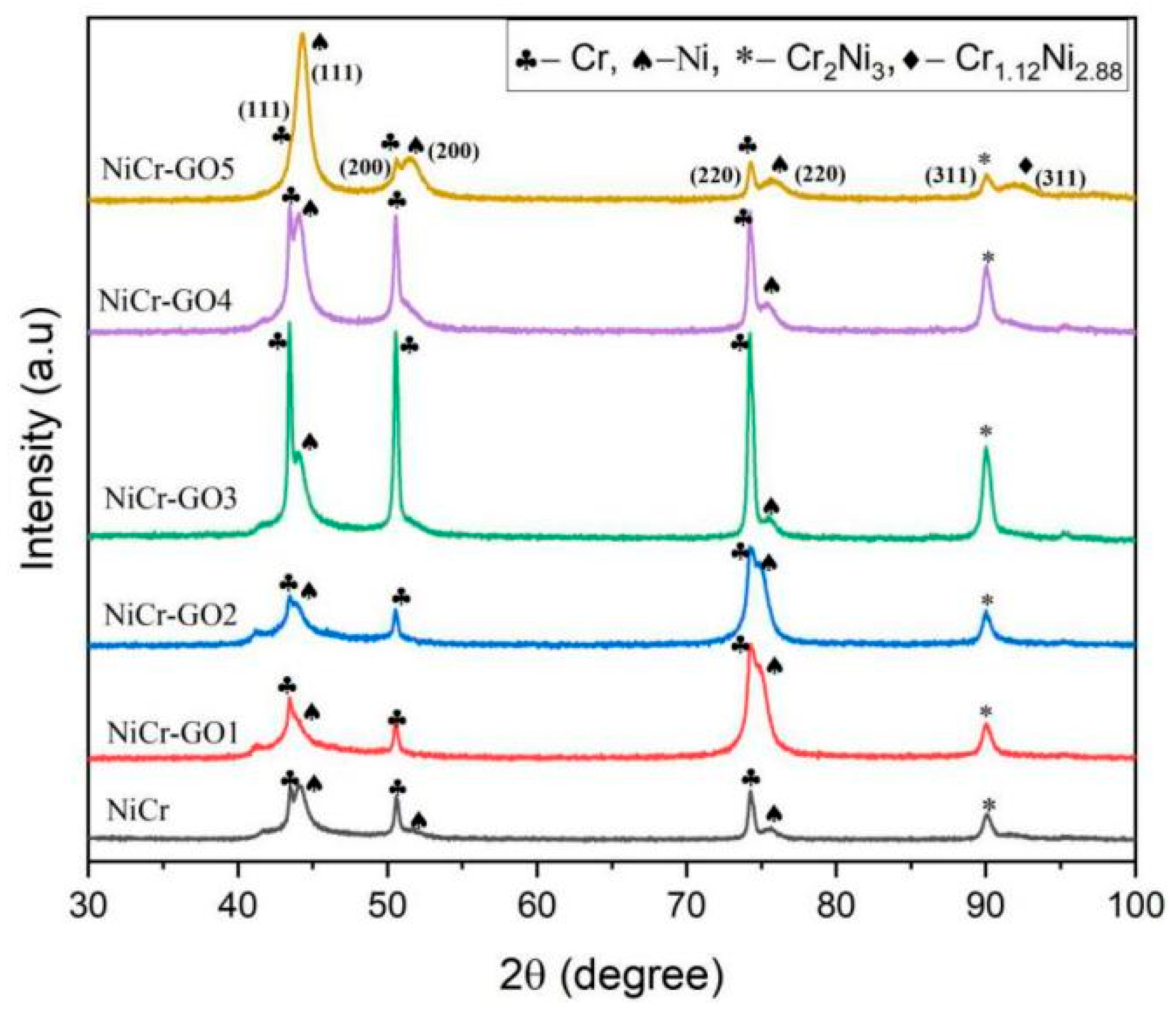
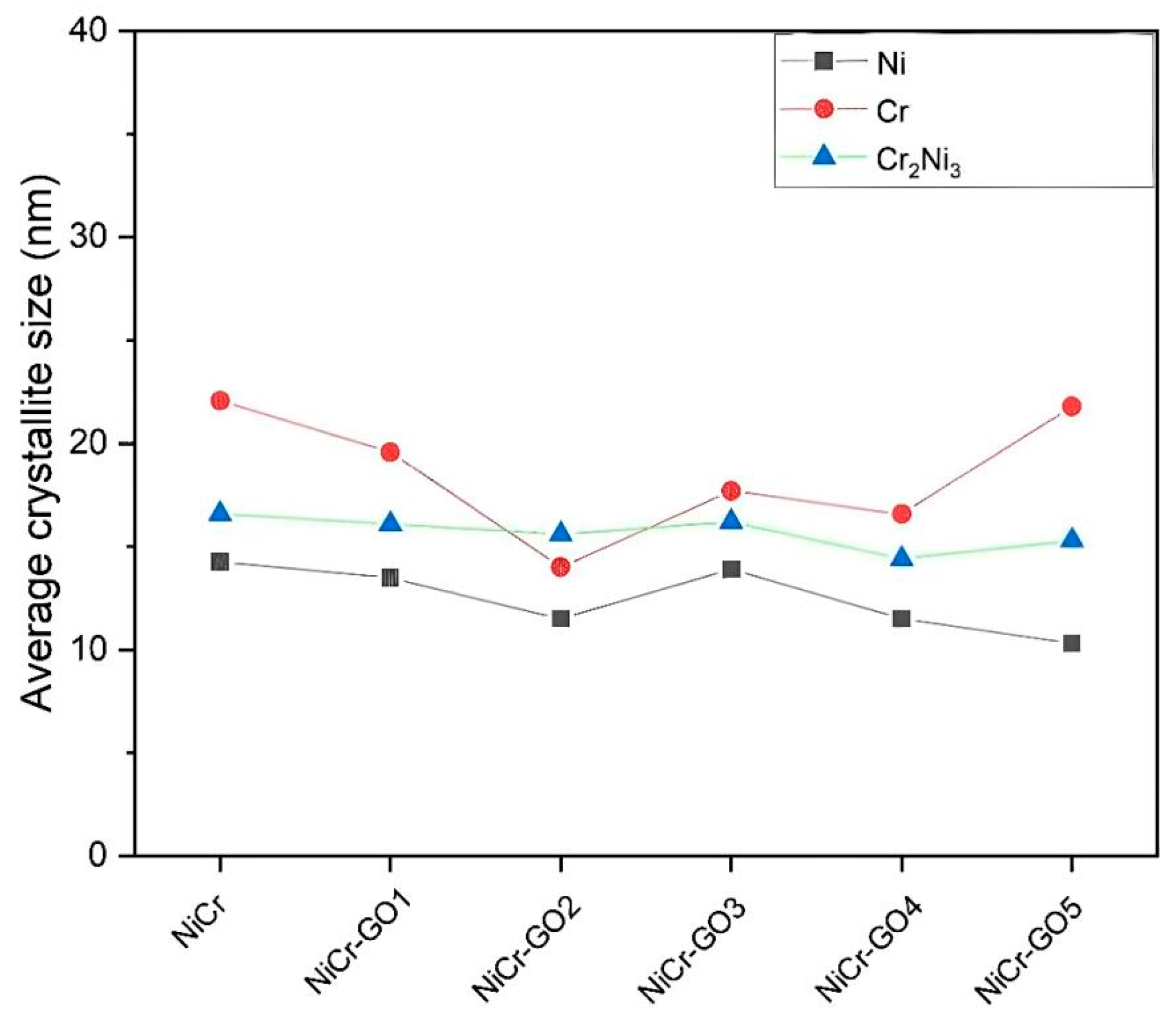
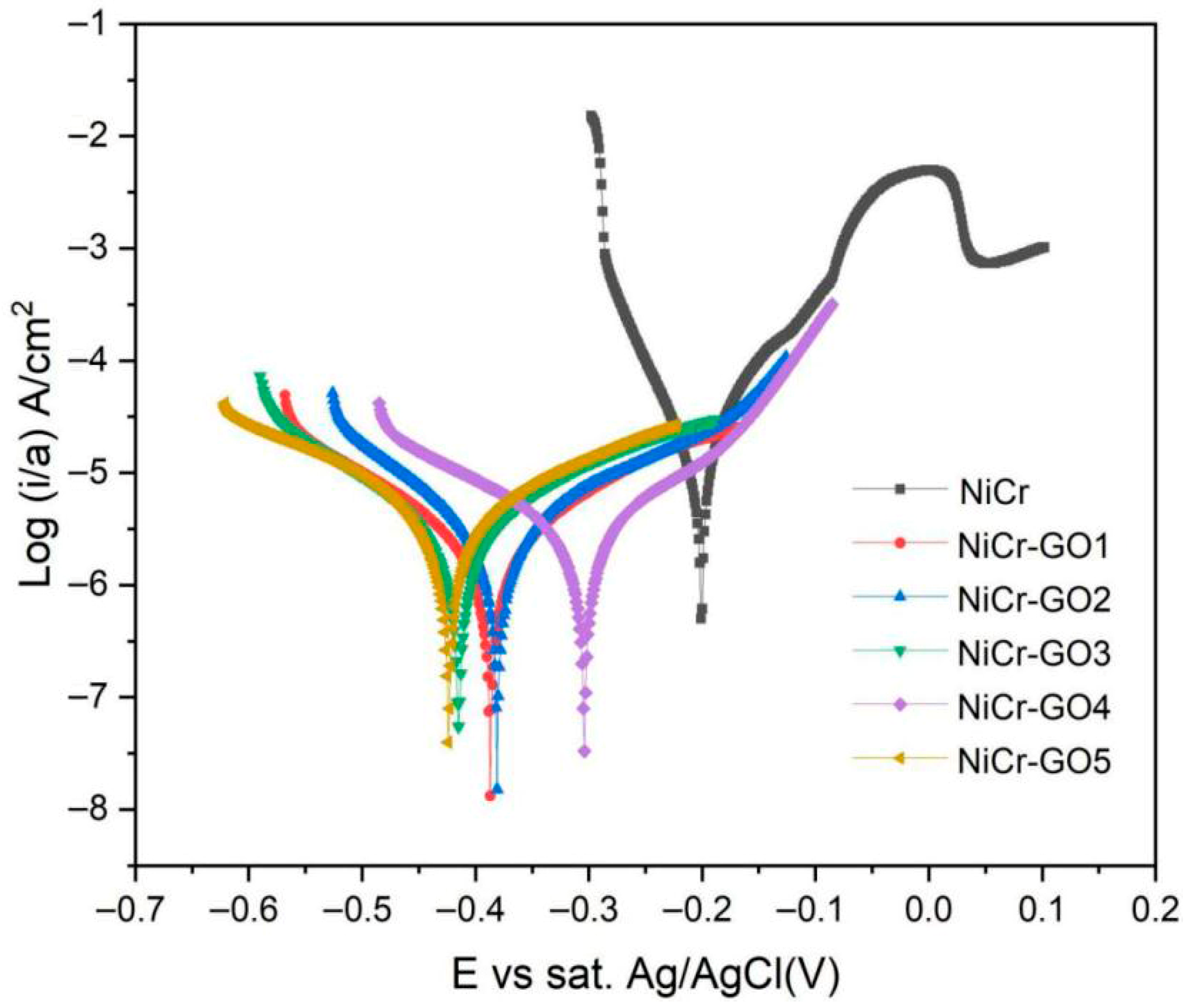
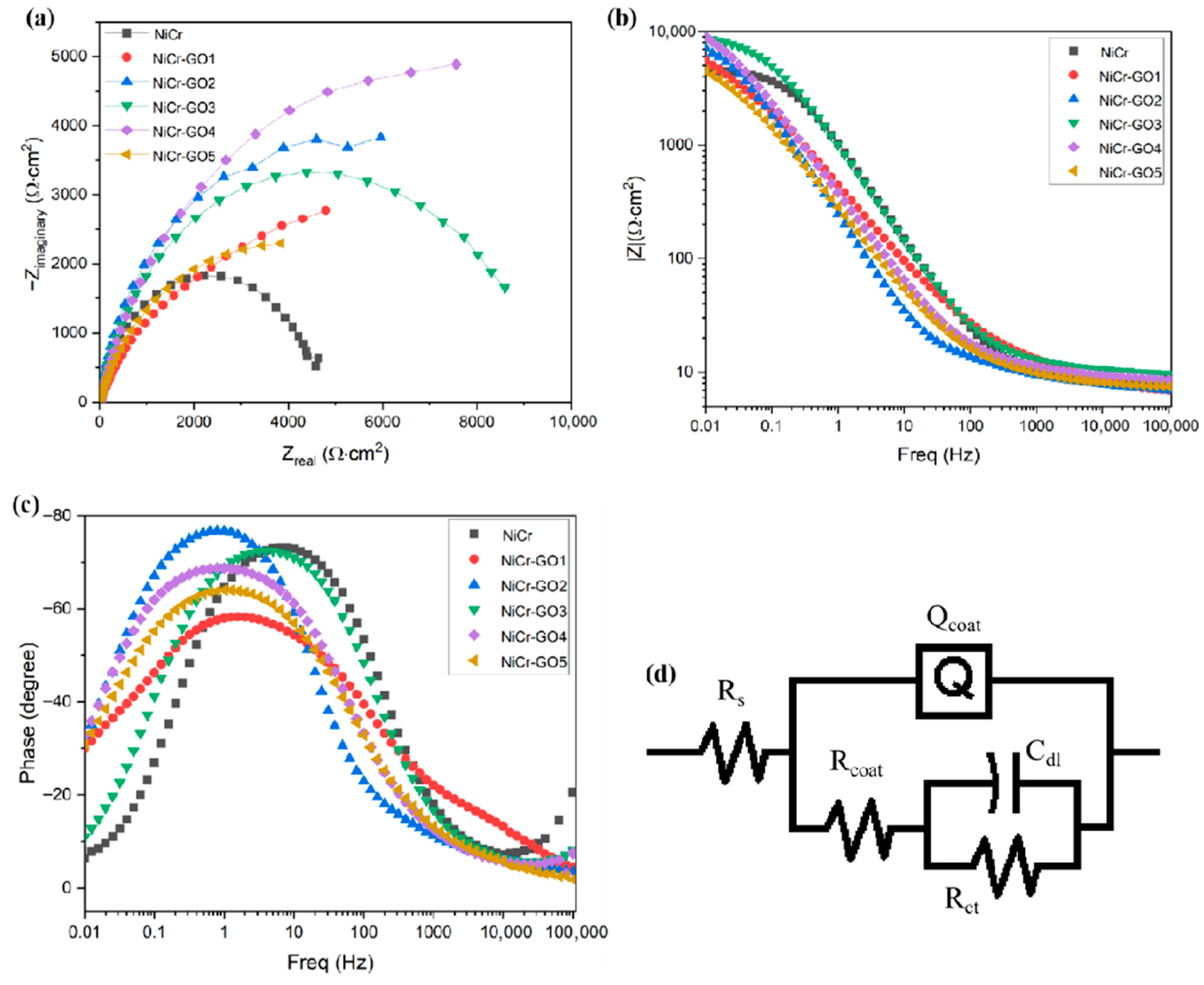

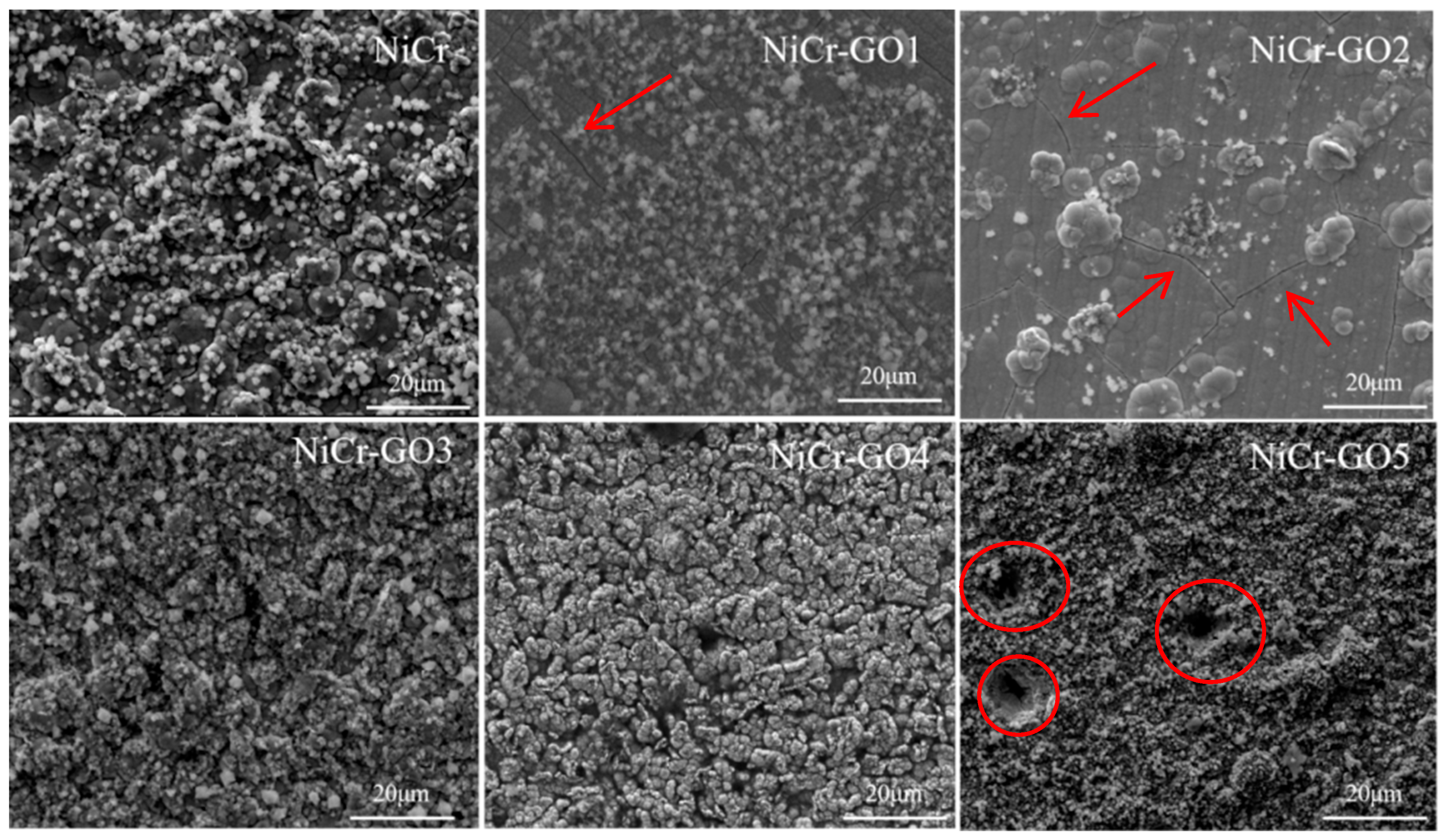
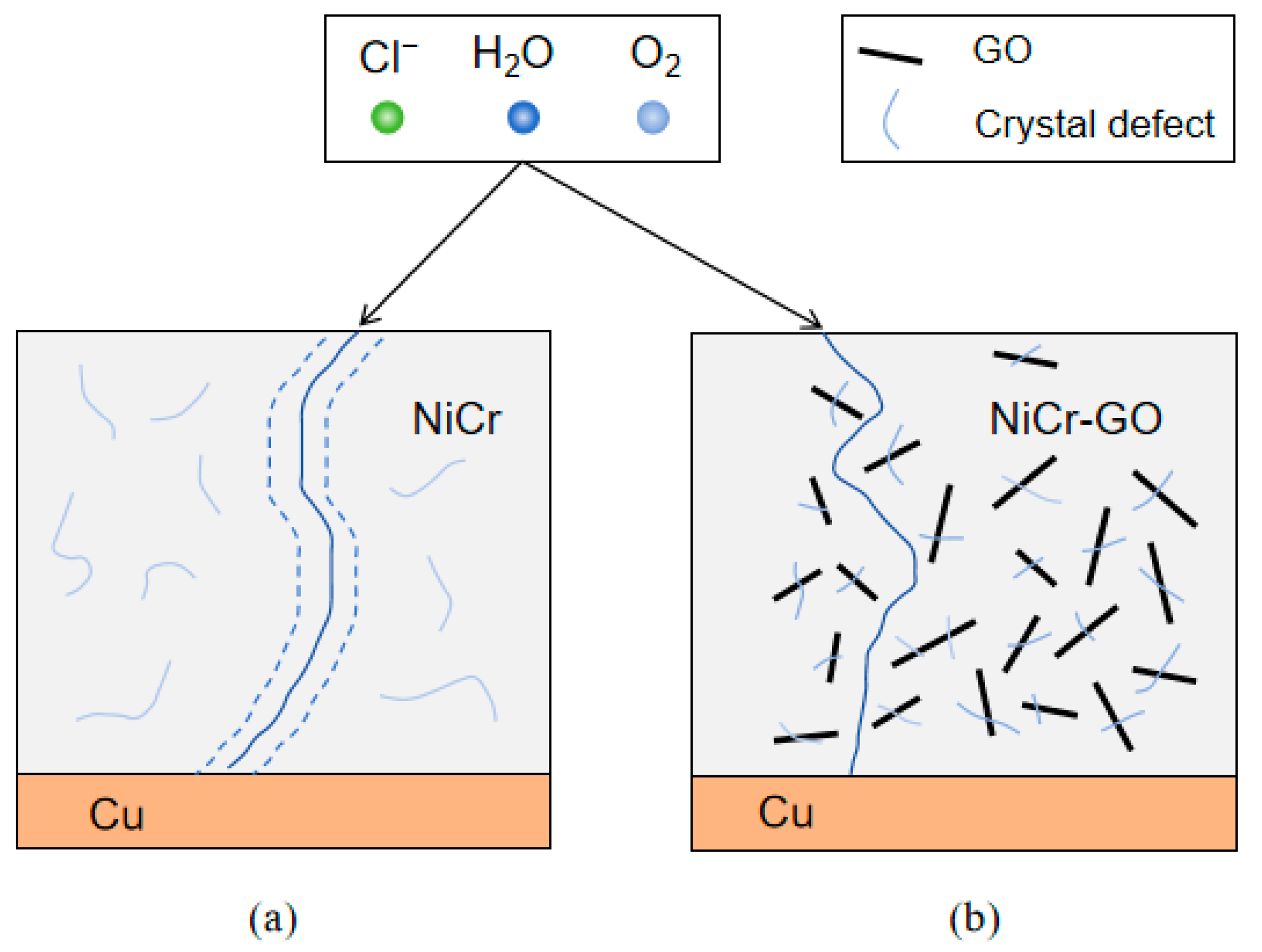
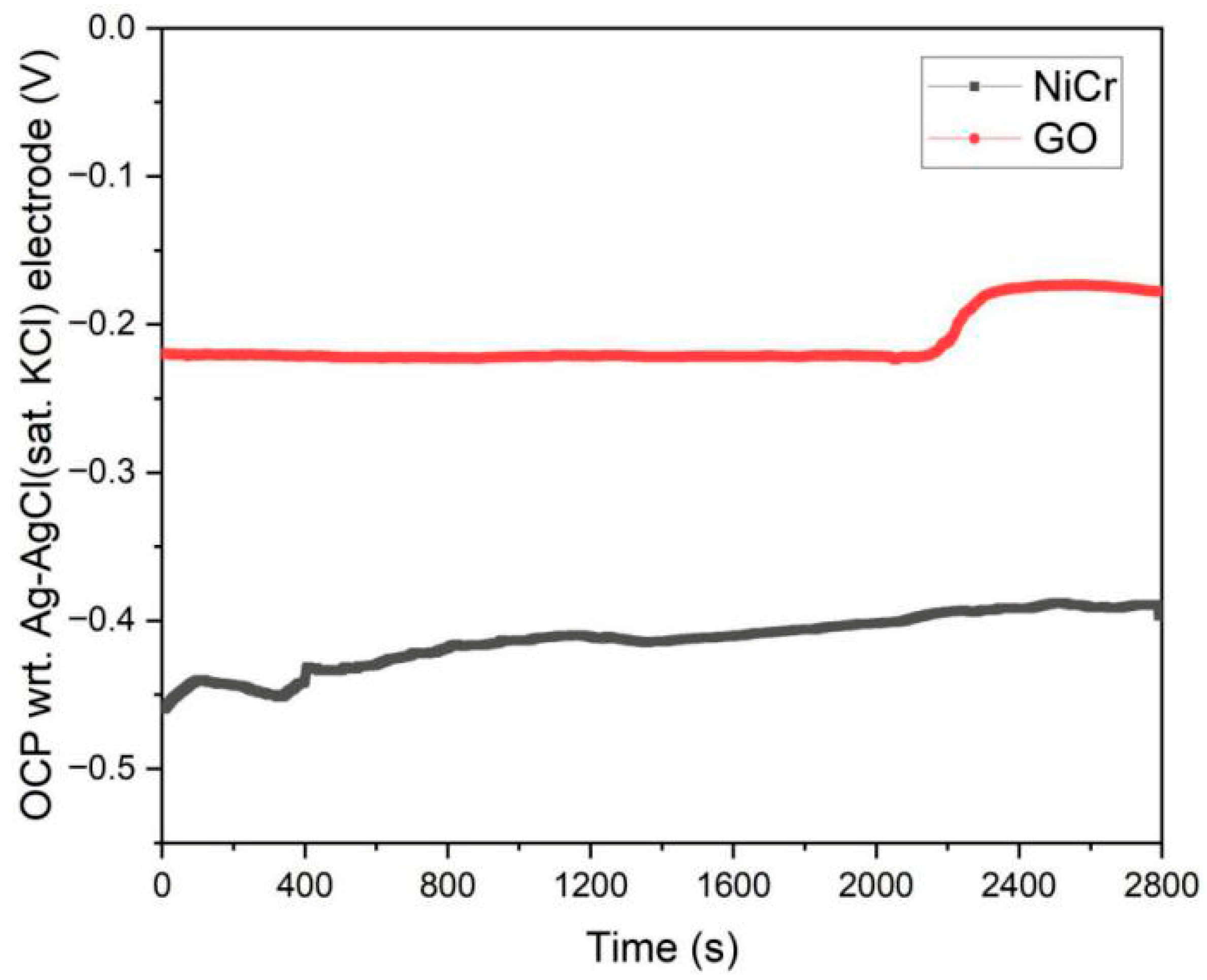

| Sample Name | Bath Composition | Concentration |
|---|---|---|
| NiCr | NiCl2·6H2O | 20 g/L |
| CrCl3·6H2O | 100 g/L | |
| H3BO3 | 50 g/L | |
| KBr | 15 g/L | |
| HCOONa | 35 g/L | |
| SDS | 0.2 g/L | |
| Citrate | 120 g/L | |
| Urea | 55 g/L | |
| Saccharin | 0.8 g/L |
| Sample Name | Bath Composition | GO Concentration |
|---|---|---|
| NiCr-GO1 | NiCr + different concentration of GO | 0.125 g/L |
| NiCr-GO2 | 0.250 g/L | |
| NiCr-GO3 | 0.500 g/L | |
| NiCr-GO4 | 0.750 g/L | |
| NiCr-GO5 | 1.000 g/L |
| Element | NiCr | NiCr-GO1 | NiCr-GO2 | NiCr-GO3 | NiCr-GO4 | NiCr-GO5 |
|---|---|---|---|---|---|---|
| C (wt%) | 4.82 | 6.27 | 10.09 | 16.49 | 23.86 | 24.35 |
| Cr (wt%) | 9.21 | 10.23 | 9.64 | 6.72 | 7.20 | 6.92 |
| Ni (wt%) | 85.97 | 83.50 | 80.27 | 76.79 | 68.94 | 68.73 |
| NiCr | NiCr-GO1 | NiCr-GO2 | NiCr-GO3 | NiCr-GO4 | NiCr-GO5 | |
|---|---|---|---|---|---|---|
| porosity (unit/cm2) | 5 | 3 | 2 | 3 | 2 | 4 |
| pore position | a | b | b | b | b | a |
| Coatings | Ecorr (V) | Icorr (μA/cm2) | Corrosion Rate (mpy) |
|---|---|---|---|
| NiCr | −0.201 | 13.24 | 6.048 |
| NiCr-GO1 | −0.387 | 3.362 | 1.531 |
| NiCr-GO2 | −0.381 | 3.561 | 1.627 |
| NiCr-GO3 | −0.415 | 4.650 | 2.188 |
| NiCr-GO4 | −0.299 | 3.235 | 1.478 |
| NiCr-GO5 | −0.423 | 9.148 | 4.180 |
| Rp (Ω·cm2) | Rs (Ω·cm2) | Qcoat (μS·secn) | n | Rcoat (Ω·cm2) | Cdl (μF/cm2) | Rct (Ω·cm2) | χ2 | |
|---|---|---|---|---|---|---|---|---|
| NiCr | 4739.44 | 8.44 | 163.6 | 0.81 | 11.56 | 32.56 | 4731 | 4.476 × 10−3 |
| NiCr-GO1 | 10,107.08 | 7.08 | 602.4 | 0.61 | 59.37 | 46.99 | 10,100 | 3.228 × 10−3 |
| NiCr-GO2 | 9999.49 | 7.49 | 448.5 | 0.76 | 10.93 | 35.31 | 9992 | 2.381 × 10−3 |
| NiCr-GO3 | 9190.04 | 10.04 | 179.2 | 0.79 | 19.38 | 33.39 | 9180 | 1.704 × 10−3 |
| NiCr-GO4 | 14,639.17 | 9.17 | 510.4 | 0.75 | 31.93 | 32.23 | 14,630 | 2.607 × 10−3 |
| NiCr-GO5 | 8418.31 | 8.31 | 919.5 | 0.73 | 7258 | 122.70 | 8410 | 4.543 × 10−3 |
Disclaimer/Publisher’s Note: The statements, opinions and data contained in all publications are solely those of the individual author(s) and contributor(s) and not of MDPI and/or the editor(s). MDPI and/or the editor(s) disclaim responsibility for any injury to people or property resulting from any ideas, methods, instructions or products referred to in the content. |
© 2025 by the authors. Licensee MDPI, Basel, Switzerland. This article is an open access article distributed under the terms and conditions of the Creative Commons Attribution (CC BY) license (https://creativecommons.org/licenses/by/4.0/).
Share and Cite
Ge, W.; Zhang, Y.; Ran, X.; Chen, T. Corrosion Resistance of Nickel/Chromium Graphene Oxide Coatings on Copper Substrate Surface and the Corrosion Resistance Mechanism of Graphene Oxide. Coatings 2025, 15, 1389. https://doi.org/10.3390/coatings15121389
Ge W, Zhang Y, Ran X, Chen T. Corrosion Resistance of Nickel/Chromium Graphene Oxide Coatings on Copper Substrate Surface and the Corrosion Resistance Mechanism of Graphene Oxide. Coatings. 2025; 15(12):1389. https://doi.org/10.3390/coatings15121389
Chicago/Turabian StyleGe, Wen, Yujia Zhang, Xia Ran, and Ting Chen. 2025. "Corrosion Resistance of Nickel/Chromium Graphene Oxide Coatings on Copper Substrate Surface and the Corrosion Resistance Mechanism of Graphene Oxide" Coatings 15, no. 12: 1389. https://doi.org/10.3390/coatings15121389
APA StyleGe, W., Zhang, Y., Ran, X., & Chen, T. (2025). Corrosion Resistance of Nickel/Chromium Graphene Oxide Coatings on Copper Substrate Surface and the Corrosion Resistance Mechanism of Graphene Oxide. Coatings, 15(12), 1389. https://doi.org/10.3390/coatings15121389




